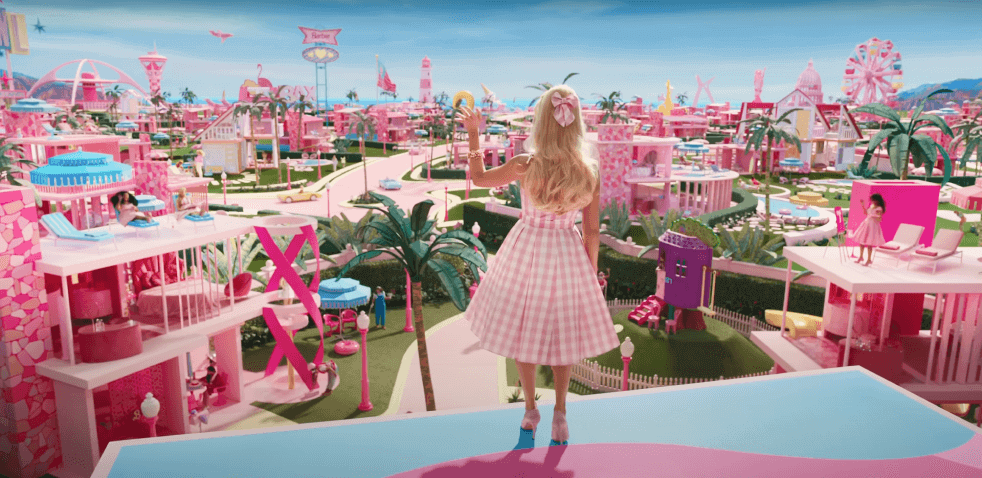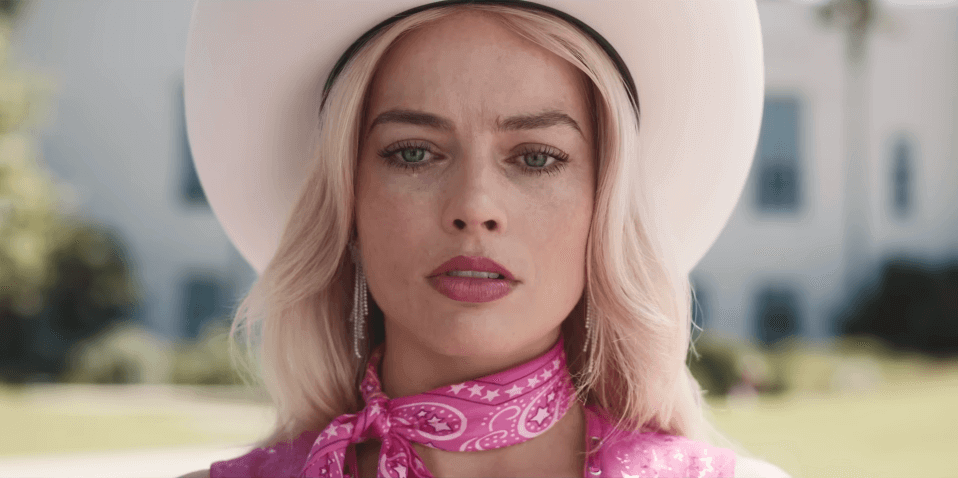TLDR: Barbie embarks on a cinematic adventure echoing Buddha’s path, delving into suffering, change, and the journey to inner peace.
In the 2023 release of “Barbie”, the iconic doll embarks on a journey that resonates with Buddha’s own journey and his teachings. From the concept of suffering to non-self, impermanence, and overcoming ignorance, the film subtly presents these themes in a relatable way.
Lead actress Margot Robbie shares that the movie is ‘kind of like the Buddha’s journey to enlightenment, is the journey that Barbie should go on’
Here are 6 moments you might have missed while looking at Ken’s abs or hearing truth bombs at the end of the movie.
*Obvious Spoiler Alerts*
Cr: Google Images
#1 From Barbieland to Buddha: An Unexpected Journey
The film begins in a utopia called Barbieland, where Barbies live a life of blissful ignorance. Similar to the story of Siddhartha Gautama, the historical Buddha, Barbie’s world is picture-perfect.
However, a burning query about mortality during a disco party shatters this illusion, propelling her on a journey beyond the confines of her plastic paradise.
“Do you ever think about dying?” – Barbie
This pivotal question echoes the Buddha’s exploration of life beyond the protected walls of his royal existence, where he encountered sickness, old age, and death. Buddha shares his realisation neatly in this sutta about old age.
“Why this laughter, why this joy, when the world is constantly burning, why, when enveloped by darkness, do you not seek for a light?” Dhammapada 146
#2 It does not last

Barbie’s perfect routine of waking up fresh, getting fake fresh milk, and having heels start to fall apart when the human-to-doll connection darkens. She starts to experience ageing and even bodily pains (anyone in their late 20s and beyond put your hands up?)
“Every day is the best day ever, and every night is girls’ night, from now until FOREVER!” – Barbie
Barbie’s ‘permanence’ narrative falls apart faster as she ventures beyond the plastic world (she tries to choose ignorance by opting for the pretty shoe instead of Birkenstock, but obviously takes the Birks upon intense nudging)
Barbie: “I never wanted anything to change!”
Gloria: “Oh honey, that’s life, it is all change”
This echoes what Buddha talked about change as one of the 3 sufferings that all beings experience in his First Noble Truth. Buddha shares that suffering can be caused by:
1) Pain (Dukkha Dukkha) experienced when spraining your ankle.
2) Mental formations (Sankhara Dukkha) experienced when you think/ judge/angst over what should/shouldn’t be done when spraining the ankle and how unfair it is to have it sprained before your wedding
3) Change (Vaparinama Dukkha) is experienced when we do not want things to change and it changes anyway. It is the painful craving of being unable to control permanence.
You can read a nifty article about it here!
#3 Ken’s Identity Crisis & realisation of non-self (sort of)
Ken’s struggle with his identity mirrors the Buddhist teaching of attachment to self. This attachment, according to Zen Master Thich Nhat Hanh, often leads to suffering. Ken’s journey reflects the Buddhist understanding of non-self and interconnectedness.
“Who am I if I am not Ken?”
This crisis of identity and the eventual acceptance of his intrinsic worth without attaching to a particular identity reflects the Buddhist teaching of letting go of attachment to self to alleviate suffering.
The moment Ken realises he doesn’t need to be tethered to the idea of ‘Barbie & Ken’ but just ‘Ken’ unlocks his attachment to control. He can finally be himself.
Of course, the film doesn’t delve deeper into Non-self. I can’t imagine moviegoers going through the teaching of non-self in a light-hearted movie.
Buddha expounds non-self through a series of questions to the five disciples. Here is one line of questioning for us to understand a glimpse of nonself.
In this example, he questions that if we had a real, full self, we would be able to command it. Failing which, how can we call this ‘me’? You can read the deep sutta here. Definitely deeper than Ken’s realisation.
“Bhikkhus, form (body) is not-self. Were form self, then this form would not lead to affliction, and one could have it of form: ‘Let my form be thus, let my form be not thus.’ And since form is not-self, so it leads to affliction, and none can have it of form: ‘Let my form be thus, let my form be not thus.” – Buddha
#4 Placing your happiness in others
Barbie has a great day every day, but Ken only has a great day if Barbie looks at him. -Narrator
Ken waits for Barbie to notice him and feels awful when it doesn’t happen. He is even jealous of other Kens who get her attention. We see this evolve into toxicity as Ken builds his entire actions based on pleasing one lady.
The act of placing all of our happiness in one person who is subjected to change, ageing, sickness, and death sets us up for future unhappiness.
The Buddha encouraged us to seek within and not without for contentment. Noting that the world is ultimately unreliable. (How many bestest of friends have we lost since we ventured into the work-life?)
To cultivate stillness and peace alongside our Kalyana Mittas (Spiritual friends) is ideal as one slowly becomes at peace in the presence of oneself. With no one to prove.
“Searching all directions with one’s awareness,
one finds no one dearer than oneself.
In the same way, others are dear to themselves.
So one should not hurt others if one loves oneself.”
To be Ken-ough!
#5 Unmasking the Real World: Suffering Unveiled

Stepping into the real world, Barbie’s journey becomes an awakening. She confronts suffering, particularly as a woman, as she experiences sexual harassment and criticism for creating unrealistic standards of beauty. This is a reflection of the first of the four noble truths in Buddhism – the existence of suffering. The world is not satisfactory
Ruth Handler, the real-life inventor of Barbie and co-founder of Mattel, serves as a mentor in the movie. She educates Barbie about suffering and the human experience, mirroring the role of a Buddhist teacher guiding disciples through the path of wisdom.
“The world is full of suffering. That’s part of being human.” – Ruth Handler
Of course, it is bleak if we stop there. If suffering is part of being human and we couldn’t do anything about it…we will all be pretty sad creatures scampering across our lives.
Zen master, Thich Nhat Hanh, shares that we shouldn’t fear suffering but rather fear that we do not have the methods to deal with suffering. The Buddha’s 8 fold path is one superb way of dealing with suffering. We just need to apply it.
“We try to transform suffering into something good. Even a lotus flower needs mud in order to grow. It can’t grow on marble. You have to recognize that there is a close connection between suffering and happiness. If you run away from suffering, you cannot find happiness. On the contrary, we should try to identify the roots of our suffering. Only then can we gain understanding and cultivate compassion.” – Thich Nhat Hanh
#6 Feel to Heal: Embracing Emotions
One of the most poignant moments in the film is when Ruth encourages Barbie to feel. This invitation to experience all emotions, including pain, resonates with the Buddhist practice of mindfulness, wherein one is encouraged to fully experience one’s emotions without judgment or aversion.
This reminded me of Buddhist teacher Tara Brach’s RAIN meditation method. This method encourages us to feel the difficult emotions in our lives in a mindful way.
You may read more about it here and try it in the article as well!
Conclusion
“Barbie” (2023) takes viewers on a journey of self-discovery, suffering, transformation, and enlightenment, mirroring the teachings of Buddhism. Through its characters and narrative, the film encourages viewers to reflect on their own understanding of life, happiness, and self, embracing the impermanence of life and the journey towards self-realisation.
Wise Steps:
- Reflect on how we can find Dhamma moments in our entertainment; there are opportunities to tie Dhamma to the drama we consume
- Where are we putting our happiness right now? Is it mostly external? Or the internal?


